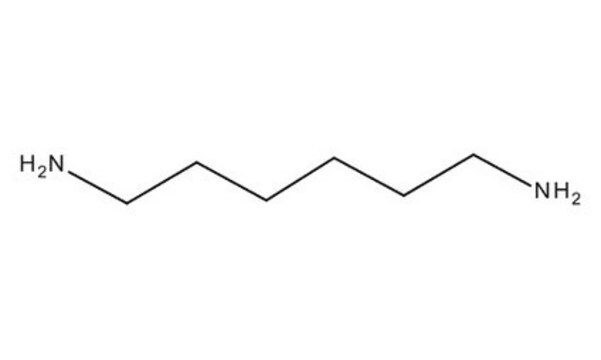D17408
1,7-Diaminoheptane
98%
Synonym(s):
1,7-Heptanediamine, Heptamethylenediamine
About This Item
Recommended Products
Assay
98%
form
solid
bp
223-225 °C (lit.)
mp
26-29 °C (lit.)
SMILES string
NCCCCCCCN
InChI
1S/C7H18N2/c8-6-4-2-1-3-5-7-9/h1-9H2
InChI key
PWSKHLMYTZNYKO-UHFFFAOYSA-N
Looking for similar products? Visit Product Comparison Guide
Related Categories
General description
Application
- Novel Hydrogels for Biomedical Applications: Research on the synthesis and characterization of pH-responsive aminated alginate derivatives using 1,7-Diaminoheptane, targeting advancements in tissue engineering and drug delivery systems. This study showcases the utility of 1,7-Diaminoheptane in developing hydrogels that respond to pH changes, potentially enhancing cell growth and targeted drug release (Khodayar et al., 2023).
- Advanced Materials in Photoluminescence: Investigation into the properties of 1,7-Diaminoheptane in enhancing broadband photoluminescence in hybrid perovskites for optoelectronic applications. This research highlights its potential in developing new materials for efficient light emission technologies (Deng et al., 2020).
Signal Word
Danger
Hazard Statements
Precautionary Statements
Hazard Classifications
Eye Dam. 1 - Skin Corr. 1B
Storage Class Code
8A - Combustible corrosive hazardous materials
WGK
WGK 3
Flash Point(F)
190.4 °F - closed cup
Flash Point(C)
88 °C - closed cup
Personal Protective Equipment
Regulatory Listings
Regulatory Listings are mainly provided for chemical products. Only limited information can be provided here for non-chemical products. No entry means none of the components are listed. It is the user’s obligation to ensure the safe and legal use of the product.
JAN Code
D17408-BULK:
D17408-5G:
D17408-25G:
D17408-VAR:
Certificates of Analysis (COA)
Search for Certificates of Analysis (COA) by entering the products Lot/Batch Number. Lot and Batch Numbers can be found on a product’s label following the words ‘Lot’ or ‘Batch’.
Already Own This Product?
Find documentation for the products that you have recently purchased in the Document Library.
Customers Also Viewed
Our team of scientists has experience in all areas of research including Life Science, Material Science, Chemical Synthesis, Chromatography, Analytical and many others.
Contact Technical Service










